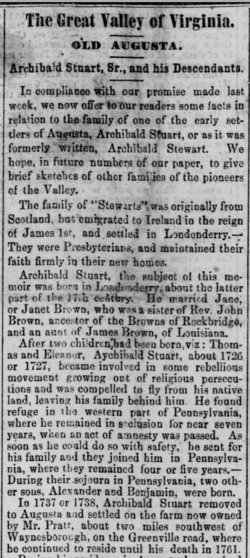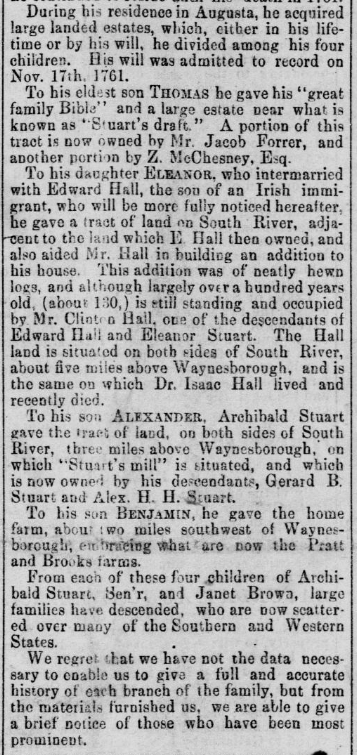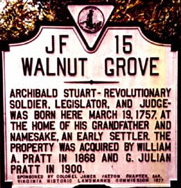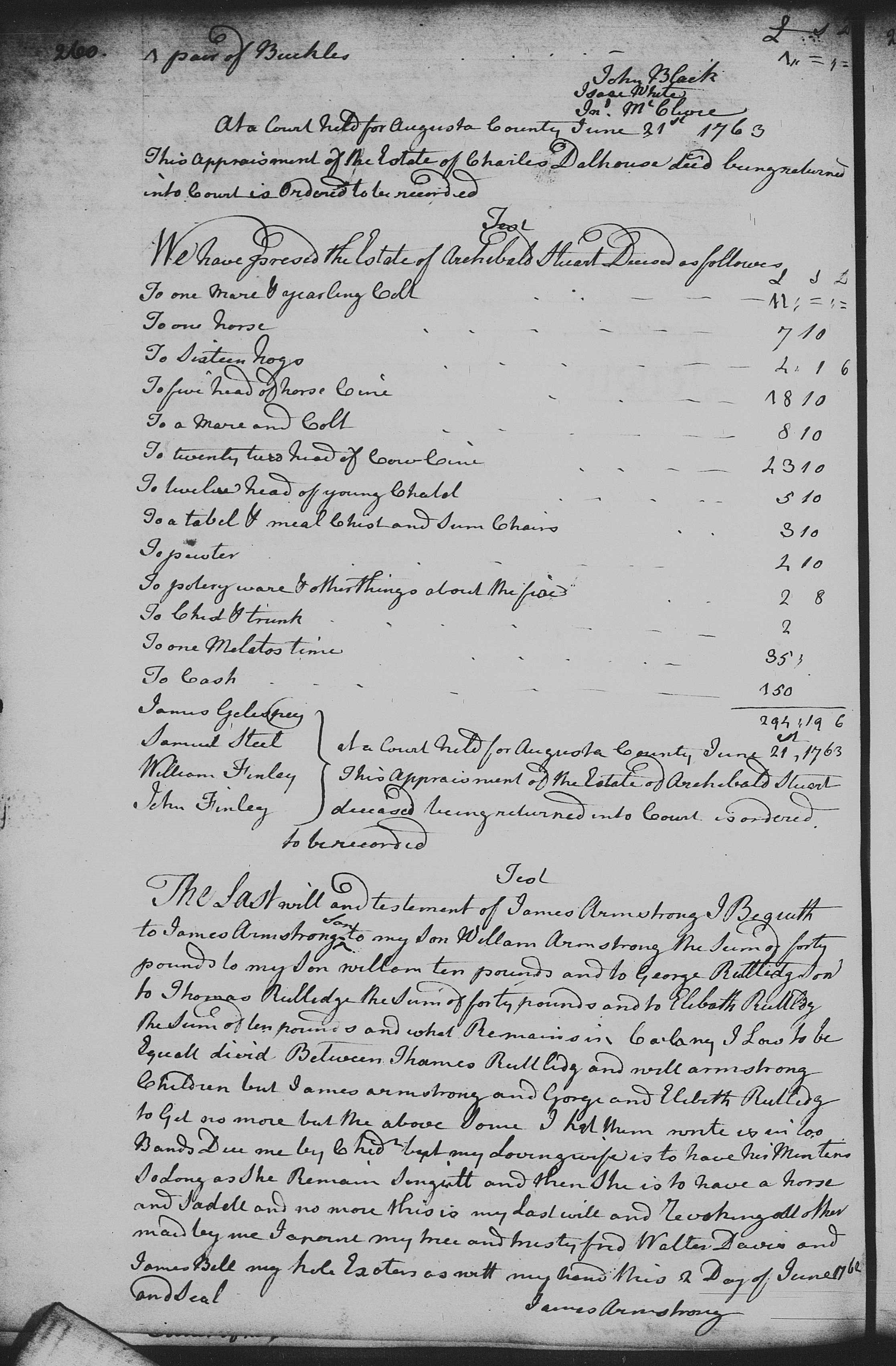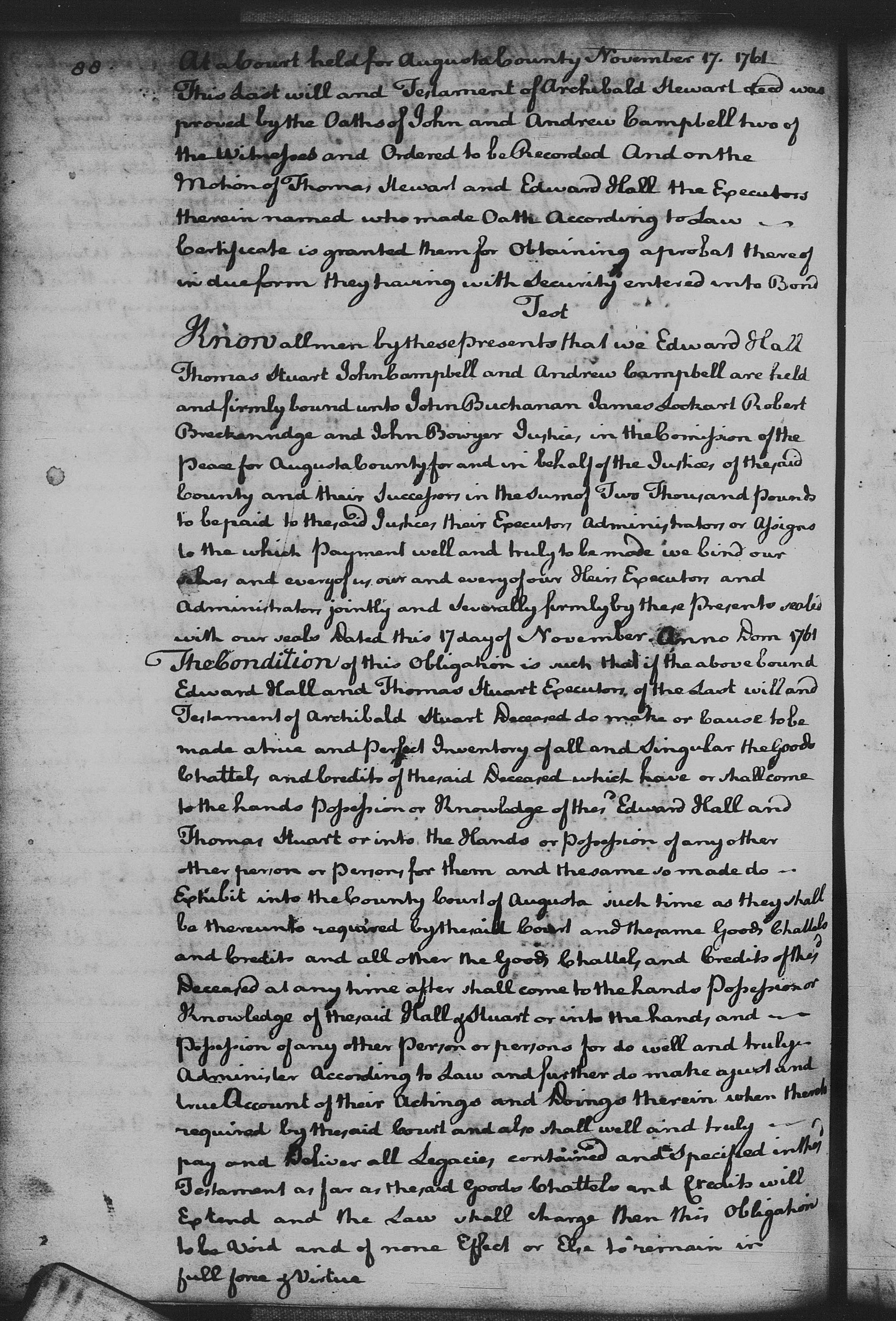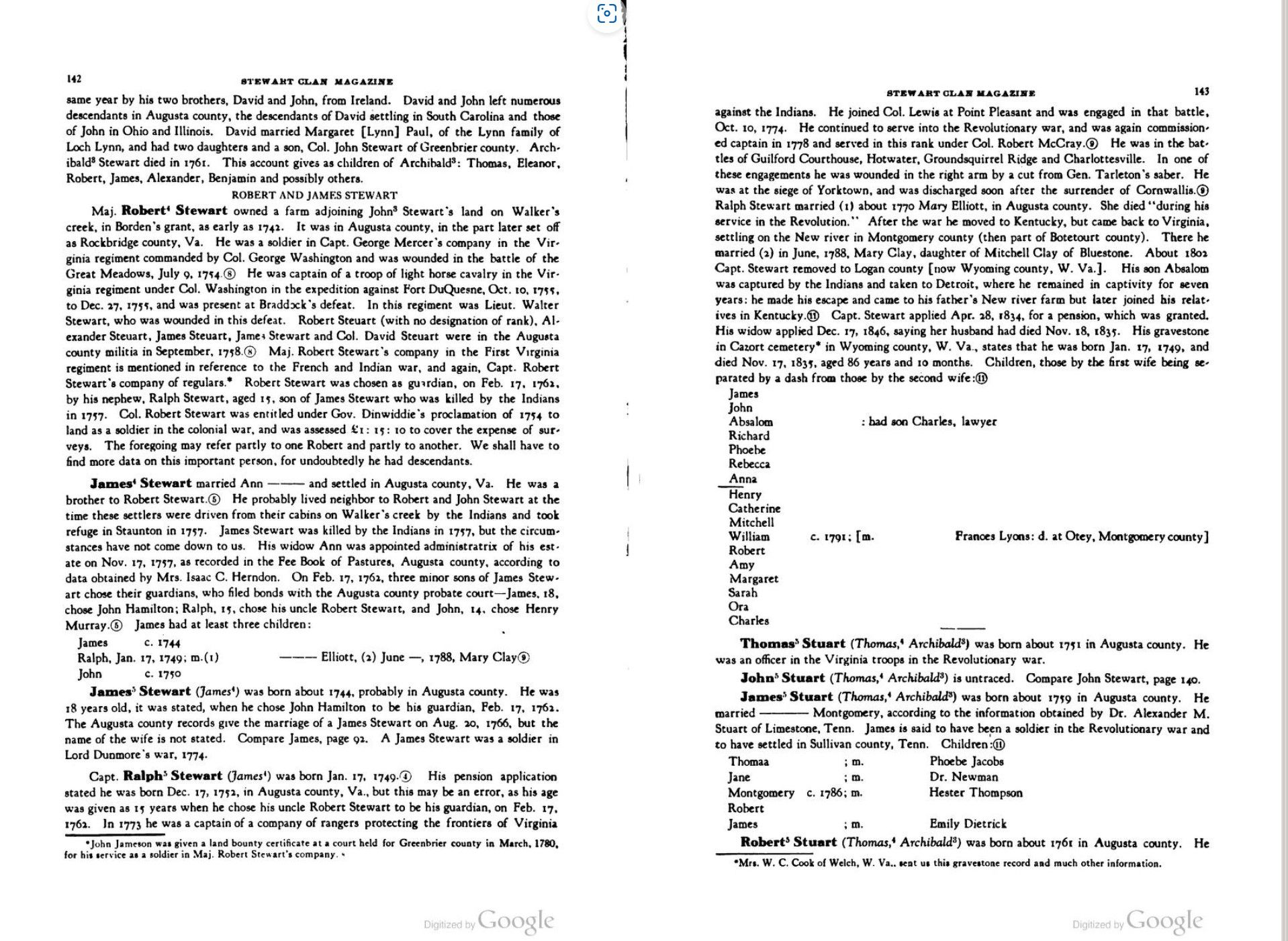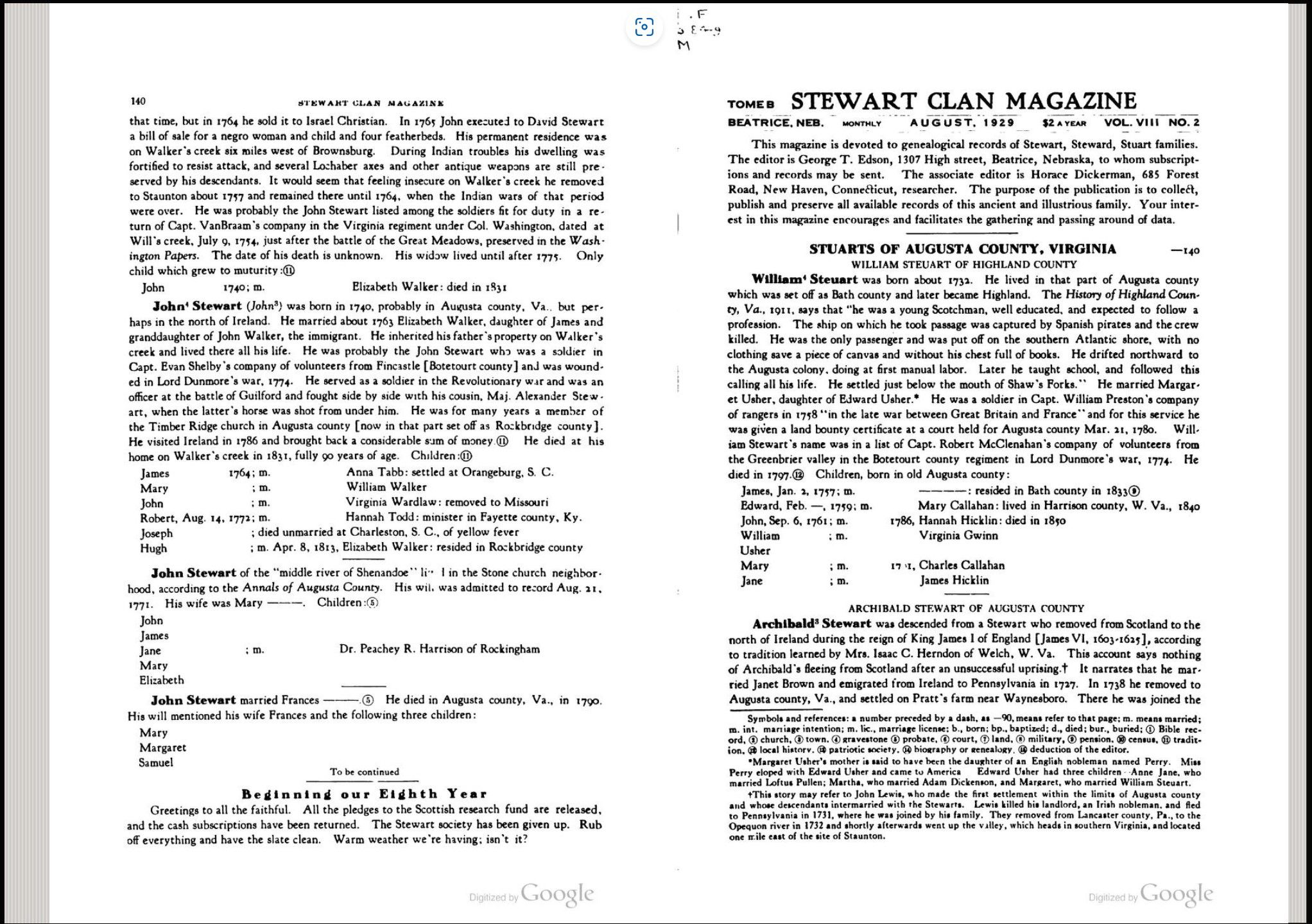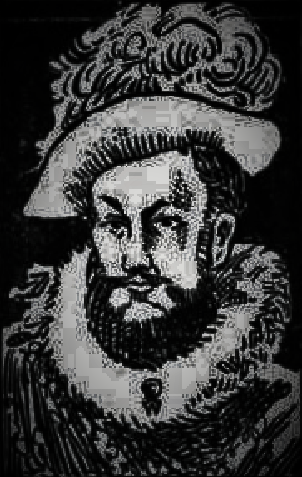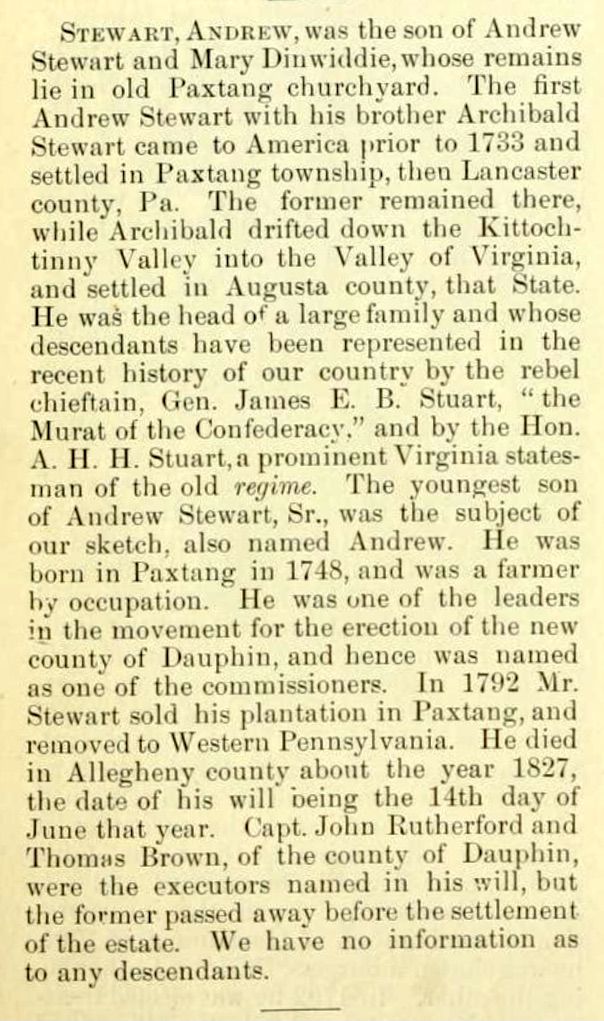Archibald married Janet Brown, (she may or may not be the "sister of Rev. John Brown.")* Their first two children were born in "Londonderry," Eleanor, about 1726 and Thomas, about 1727. After arriving in the new land, they had two more known children while in Pennsylvania: Alexander, 27 Aug 1734 and Benjamin, about 1736.
According to J. Lewis Peyton and the Stewart Clan Magazine, Archibald is believed to have taken part in an armed revolt in defense of his religious rights, or lack of. He left Ireland without his wife and two children, fleeing to the American colony. He arrived in Pennsylvania, remaining in seclusion using a bogus name for about seven years.** Following some kind of amnesty, his family was able to come to America to be with him. Sons Alexander and Benjamin were born in Pennsylvania. In 1738 they settled in Augusta County, at Walnut Grove. Archibald was considered an early settler of the area. He purchased about 500 acres there. The existing home was built in about 1820, by his family, likely over the older home (as was commonly done).
"Archibald Stuart, a native of Ireland, about the year 1725, was obliged to leave England with others on account of promoting an armed insurrection to defend their religious rights. He managed with great difficulty to escape, and leaving his wife and two children, Thomas and Eleanor behind, fled to America. He came to Pennsylvania and remained in exclusion for seven years, living under the assumed name of ----. An act of amnesty being passed, he sent for his family. They came in 1732, with his wife's brother, John Brown. While in Pennsylvania Alexander and Benjamin Stuart were born." Genealogy of the Descendants of John Walker of Wigton, Scotland…, by Emma Siggins White, Missouri, p 33-34+.
Archibald Stuart surveyed 250 acres in Paxtang, Lancaster Co., PA on 17 Nov 1737 on warrant #156, but it was not patented (paid & recorded), page 192 of the S index. Land was frequently squatted on for years before a warrant was applied for to survey and purchase it. Note his brother Andrew Stewart, 1699 - 1774, plus 4 others, are buried at Paxtang Cemetery (FaG #87968720).
In 1751, Archibald Stuart purchased 500 acres in the Beverley Patent in Augusta Co., VA and appears on J.R. Hildebrand's 1954 map of all the early original grantees.
Archibald died between 5 Sep 1759 when he made his will and prior to 17 Nov 1761 when it was recorded in Augusta County, Virginia probate (Will Book 3. p 87-88). All four of his known children are listed in it. He died near Waynesboro, Augusta County, Virginia at his home Walnut Grove, in South River Township. It is sometimes referred to as "Pratt's farm." In 1868, Walnut Grove was sold to architect William Abbot Pratt. Pratt was also the superintendent for the University of Virginia. In 1900, it went to his son G. Julian Pratt, a Civil War Soldier.
Written will: Page 87.--5th September, 1759. Archibald Stewart's will-Wife, Janet; son, Thomas, his Great Bible; daughter, Eleanor, 5 shillings; son, Alexander, tract adjoining Andw. McClure's land; grandson, Archibald Stewart, £10 when aged 10 years; son, Benj. Stewart. Executors, Thos. Stewart, Edward Hall. Teste: Jno. and Andw. Campbell, Jno. Finley. Proved, 17th November, 1761, by Jno. and Andrew Campbell. Executors qualified, with Jno. Campbell. Andrew Campbell. Chalkley's Chronicles of the Scotch-Irish Settlement, Vol. 3, page 66.
Page 260.--21st June, 1763. Archibald Stewart's appraisement (by James Galespy, Saml. Steel, Wm. Finley, John Finley), approved and recorded. Lyman Chalkley's Chronicles of the Scotch-Irish Settlement, Vol. 3, p 79.
His son, "Thomas Stuart was not only an industrious farmer and a public-minded individual, but he was a devoted churchman. When the subscriptions were taken for the erection of the log cabin that was to house the Tinkling Spring congregation, he contributed liberally, as did his father. His farm of 500 acres and more was about four miles southeast of his father's home and in the valley of South fork of the Shenandoah River; the 'Great Spring,' a noted historical spot, was a few miles downstream. His place became known as Stuart's Draft. At the meeting of Presbytery, April 12, 1775, held at Timber Ridge, it was decided to seek subscriptions for the 'encouragement of the Academy to be established at Augusta, and Thomas Stewart [Stuart] and Walter Davis were assigned the task in the Tinkling Spring congregation. Perhaps the reason Stuart was chosen was because he had sponsored a school on his farm for some time and was keenly interested in education. Edward Hall, his brother-in-law, also operated a school on his farm farther down the Shenandoah Valley." Rockbridge County, Virginia Notebook, based on George West Diehl's articles in the News Gazette, compiled by A Maxim Coppage, McDowell Publications, 1982, p.7.
"Archibald Stuart was a Presbyterian immigrant to Augusta County in 1738. He was from a Scotch family of Londonderry background. The best information available indicates he was engaged in an insurrection in defense of his religious rights and was forced to flee to America in 1725. having left his family behind and after living quietly for seven years in Pennsylvania, he was released from danger of arrest by a general amnesty in 1732, and he sent for his family, consisting of his wife Janet, his son Thomas, and daughter Eleanor and his wife's small brother. The family moved to Augusta County in 1738 and settled three miles east of Tinkling Spring on a farm known as the Pratt farm on U.S. Highway 340. They were destined to play a large part in both state and church affairs and to see the establishment of Tinkling Spring, the oldest Presbyterian Church in the Valley. It was Archibald's son Thomas Stuart who later became the founder of Stuarts Draft." Above was included in a long article at stuartsdraft dot homestead dot com. It also connects to an 11 Aug 1972 article that appeared in the Stuarts Draft Hub, published weekly with the News Virginian, Vol.1, #1, about the town and family.
The 8 Jul 1873 issue of the Staunton Spectator, which had frequent genealogical articles on locals, including one titled The Great Valley of Virginia, Old Augusta, Archibald Stuart, Sr. and his Descendants, by an unlisted writer/compiler. It covers 4 large columns on the front page and a 1/4 on the last page, #4. Only part of the article was posted here due to the size and quality of the paper. The author includes a blip about the name Stewart. It was changed to Stuart after Mary Stewart married the Dauphin of France. The French alphabet does not included a W so they altered it. (Also many alterations of the local Scots-Irish surnames, were changed, after they arrived in the colonies.) Many old sources state Archibald was related to Mary Queen of Scotts (Henry Stuart AKA Lord Darnley & their son James VI, plus Mary and Henry were both great grandkids of Henry VII) and Robert the Bruce (through his daughter Marjorie, wife of Walter Stewart).
I've heard many different versions of why Archibald left the UK, and came alone to the colonies, but this 1873 paper describes the full circle. In about 1726-27, Archibald was part of a rebellious movement against religious prosecution by the English and was forced to leave Britain, leaving his wife and young children behind. "...He found refuge in the western part of Pennsylvania, where he remained in seclusion for near seven years, when an act of amnesty was passed." His family joined him in Pennsylvania in about 1832. In approximately "In 1737 or 1738, Archibald Stuart removed to Augusta and settled on the farm now owned by Mr. Pratt, about two miles southwest of Waynesborough, on the Greenville road, where he continued to reside until his death in 1761."
"Stewart, Andrew, was the son of Andrew Stewart and Mary Dinwiddie, whose parents lie in old Paxtang churchyard. The first Andrew Stewart with his brother Archibald Stewart came to America prior ot 1733 and settled in Paxtang township, then Lancaster county, Pa. The former remained there, while Archibald Stuart drifted down the Kittochtinny Valley in the Valley of Virginia and settled in Augusta county, that State. He wa.s the head of a large family and whose descendants have been represented in the recent history of our country by the rebel chieftain. Gen. James E. B. Stuart, "the Murat of the Confederacy." and by the Hon. A. H. H. Stuart, a prominent Virginia statesman of the old regime. The youngest son of Andrew, Sr., was the subject of our sketch, also named Andrew. He was born in Paxtang in 1748, and was a farmer by occupation. He was one of the leaders in the movement for the erection of the new county of Dauphin, and hence was named as one of the commissioners. In 1792 Mr. Stewart sold his plantation in Paxtang, and removed to Western Pennsylvania. He died in Allegheny county about the year 1827, the date of his will being the 14th day of June that year. Capt. John Rutherford and Thomas Brown, of the county of Dauphin, were the executors named in his will , but the former passed away befreo the settlement of the estate." Commemorative Biographical Encyclopedia of Dauphin Co., PA, 1896 by J.M. Runk & Co, Chambersburg, PA, p 184 (see photo).
-Was he "christened in 1697 Londonderry, Ireland," per KJ ?(unsourced).
-Was he the first born son of Andrew Stewart (abt 1672 - 1715 in County Tyrone), the 7th Lord of Castle Stewart, of County Tyrone and Eleanor Dailway or Dalloway of beautiful County Antrim, in current Northern Ireland. Questions arise and few sources are available. Verify. Seek data.
-"If you are related to these Stuarts you may be interested to know that the current, 9th Earl Castle Stewart, direct descendant of Archibald's presumed father, Andrew Stuart, 7th Baron Castle Stewart, has had his DNA tested at Family Tree DNA." Shared by AMS.
* Many sources say Janet was the sister of Rev. John Brown however one says she was not his sister: See John White Stuart, III's dissertation called The Rev. John Brown of Virginia (1728 - 1803): His Life and Selected Sermons, dissertation, University of MA, 1988.
**I note other Stewarts in Paxtang Twp., Dauphin Co., Pennsylvania, including his brother Andrew, died 1774, buried at the Paxtang Presbyterian Churchyard in Harrisburg and Capt. Lazarus Stewart, died 1778. See FaG #87968720. Prior to 1785, this area was previously in Lancaster Co. See the Commemorative Biographical Encyclopedia of Dauphin Co., PA, 1896 by J. M. Runk & Co., Chambersburg, PA , p 145-49.
LEAD, no dates listed. The Public Records Office in N. Ireland (PRONI) lists in privately deposited papers: Stuart, Archibald (depositor) papers, #D1675. Suspect this needs to be done in person.
Bio researched and written by LSP, do not reproduce, all rights reserved.
Archibald married Janet Brown, (she may or may not be the "sister of Rev. John Brown.")* Their first two children were born in "Londonderry," Eleanor, about 1726 and Thomas, about 1727. After arriving in the new land, they had two more known children while in Pennsylvania: Alexander, 27 Aug 1734 and Benjamin, about 1736.
According to J. Lewis Peyton and the Stewart Clan Magazine, Archibald is believed to have taken part in an armed revolt in defense of his religious rights, or lack of. He left Ireland without his wife and two children, fleeing to the American colony. He arrived in Pennsylvania, remaining in seclusion using a bogus name for about seven years.** Following some kind of amnesty, his family was able to come to America to be with him. Sons Alexander and Benjamin were born in Pennsylvania. In 1738 they settled in Augusta County, at Walnut Grove. Archibald was considered an early settler of the area. He purchased about 500 acres there. The existing home was built in about 1820, by his family, likely over the older home (as was commonly done).
"Archibald Stuart, a native of Ireland, about the year 1725, was obliged to leave England with others on account of promoting an armed insurrection to defend their religious rights. He managed with great difficulty to escape, and leaving his wife and two children, Thomas and Eleanor behind, fled to America. He came to Pennsylvania and remained in exclusion for seven years, living under the assumed name of ----. An act of amnesty being passed, he sent for his family. They came in 1732, with his wife's brother, John Brown. While in Pennsylvania Alexander and Benjamin Stuart were born." Genealogy of the Descendants of John Walker of Wigton, Scotland…, by Emma Siggins White, Missouri, p 33-34+.
Archibald Stuart surveyed 250 acres in Paxtang, Lancaster Co., PA on 17 Nov 1737 on warrant #156, but it was not patented (paid & recorded), page 192 of the S index. Land was frequently squatted on for years before a warrant was applied for to survey and purchase it. Note his brother Andrew Stewart, 1699 - 1774, plus 4 others, are buried at Paxtang Cemetery (FaG #87968720).
In 1751, Archibald Stuart purchased 500 acres in the Beverley Patent in Augusta Co., VA and appears on J.R. Hildebrand's 1954 map of all the early original grantees.
Archibald died between 5 Sep 1759 when he made his will and prior to 17 Nov 1761 when it was recorded in Augusta County, Virginia probate (Will Book 3. p 87-88). All four of his known children are listed in it. He died near Waynesboro, Augusta County, Virginia at his home Walnut Grove, in South River Township. It is sometimes referred to as "Pratt's farm." In 1868, Walnut Grove was sold to architect William Abbot Pratt. Pratt was also the superintendent for the University of Virginia. In 1900, it went to his son G. Julian Pratt, a Civil War Soldier.
Written will: Page 87.--5th September, 1759. Archibald Stewart's will-Wife, Janet; son, Thomas, his Great Bible; daughter, Eleanor, 5 shillings; son, Alexander, tract adjoining Andw. McClure's land; grandson, Archibald Stewart, £10 when aged 10 years; son, Benj. Stewart. Executors, Thos. Stewart, Edward Hall. Teste: Jno. and Andw. Campbell, Jno. Finley. Proved, 17th November, 1761, by Jno. and Andrew Campbell. Executors qualified, with Jno. Campbell. Andrew Campbell. Chalkley's Chronicles of the Scotch-Irish Settlement, Vol. 3, page 66.
Page 260.--21st June, 1763. Archibald Stewart's appraisement (by James Galespy, Saml. Steel, Wm. Finley, John Finley), approved and recorded. Lyman Chalkley's Chronicles of the Scotch-Irish Settlement, Vol. 3, p 79.
His son, "Thomas Stuart was not only an industrious farmer and a public-minded individual, but he was a devoted churchman. When the subscriptions were taken for the erection of the log cabin that was to house the Tinkling Spring congregation, he contributed liberally, as did his father. His farm of 500 acres and more was about four miles southeast of his father's home and in the valley of South fork of the Shenandoah River; the 'Great Spring,' a noted historical spot, was a few miles downstream. His place became known as Stuart's Draft. At the meeting of Presbytery, April 12, 1775, held at Timber Ridge, it was decided to seek subscriptions for the 'encouragement of the Academy to be established at Augusta, and Thomas Stewart [Stuart] and Walter Davis were assigned the task in the Tinkling Spring congregation. Perhaps the reason Stuart was chosen was because he had sponsored a school on his farm for some time and was keenly interested in education. Edward Hall, his brother-in-law, also operated a school on his farm farther down the Shenandoah Valley." Rockbridge County, Virginia Notebook, based on George West Diehl's articles in the News Gazette, compiled by A Maxim Coppage, McDowell Publications, 1982, p.7.
"Archibald Stuart was a Presbyterian immigrant to Augusta County in 1738. He was from a Scotch family of Londonderry background. The best information available indicates he was engaged in an insurrection in defense of his religious rights and was forced to flee to America in 1725. having left his family behind and after living quietly for seven years in Pennsylvania, he was released from danger of arrest by a general amnesty in 1732, and he sent for his family, consisting of his wife Janet, his son Thomas, and daughter Eleanor and his wife's small brother. The family moved to Augusta County in 1738 and settled three miles east of Tinkling Spring on a farm known as the Pratt farm on U.S. Highway 340. They were destined to play a large part in both state and church affairs and to see the establishment of Tinkling Spring, the oldest Presbyterian Church in the Valley. It was Archibald's son Thomas Stuart who later became the founder of Stuarts Draft." Above was included in a long article at stuartsdraft dot homestead dot com. It also connects to an 11 Aug 1972 article that appeared in the Stuarts Draft Hub, published weekly with the News Virginian, Vol.1, #1, about the town and family.
The 8 Jul 1873 issue of the Staunton Spectator, which had frequent genealogical articles on locals, including one titled The Great Valley of Virginia, Old Augusta, Archibald Stuart, Sr. and his Descendants, by an unlisted writer/compiler. It covers 4 large columns on the front page and a 1/4 on the last page, #4. Only part of the article was posted here due to the size and quality of the paper. The author includes a blip about the name Stewart. It was changed to Stuart after Mary Stewart married the Dauphin of France. The French alphabet does not included a W so they altered it. (Also many alterations of the local Scots-Irish surnames, were changed, after they arrived in the colonies.) Many old sources state Archibald was related to Mary Queen of Scotts (Henry Stuart AKA Lord Darnley & their son James VI, plus Mary and Henry were both great grandkids of Henry VII) and Robert the Bruce (through his daughter Marjorie, wife of Walter Stewart).
I've heard many different versions of why Archibald left the UK, and came alone to the colonies, but this 1873 paper describes the full circle. In about 1726-27, Archibald was part of a rebellious movement against religious prosecution by the English and was forced to leave Britain, leaving his wife and young children behind. "...He found refuge in the western part of Pennsylvania, where he remained in seclusion for near seven years, when an act of amnesty was passed." His family joined him in Pennsylvania in about 1832. In approximately "In 1737 or 1738, Archibald Stuart removed to Augusta and settled on the farm now owned by Mr. Pratt, about two miles southwest of Waynesborough, on the Greenville road, where he continued to reside until his death in 1761."
"Stewart, Andrew, was the son of Andrew Stewart and Mary Dinwiddie, whose parents lie in old Paxtang churchyard. The first Andrew Stewart with his brother Archibald Stewart came to America prior ot 1733 and settled in Paxtang township, then Lancaster county, Pa. The former remained there, while Archibald Stuart drifted down the Kittochtinny Valley in the Valley of Virginia and settled in Augusta county, that State. He wa.s the head of a large family and whose descendants have been represented in the recent history of our country by the rebel chieftain. Gen. James E. B. Stuart, "the Murat of the Confederacy." and by the Hon. A. H. H. Stuart, a prominent Virginia statesman of the old regime. The youngest son of Andrew, Sr., was the subject of our sketch, also named Andrew. He was born in Paxtang in 1748, and was a farmer by occupation. He was one of the leaders in the movement for the erection of the new county of Dauphin, and hence was named as one of the commissioners. In 1792 Mr. Stewart sold his plantation in Paxtang, and removed to Western Pennsylvania. He died in Allegheny county about the year 1827, the date of his will being the 14th day of June that year. Capt. John Rutherford and Thomas Brown, of the county of Dauphin, were the executors named in his will , but the former passed away befreo the settlement of the estate." Commemorative Biographical Encyclopedia of Dauphin Co., PA, 1896 by J.M. Runk & Co, Chambersburg, PA, p 184 (see photo).
-Was he "christened in 1697 Londonderry, Ireland," per KJ ?(unsourced).
-Was he the first born son of Andrew Stewart (abt 1672 - 1715 in County Tyrone), the 7th Lord of Castle Stewart, of County Tyrone and Eleanor Dailway or Dalloway of beautiful County Antrim, in current Northern Ireland. Questions arise and few sources are available. Verify. Seek data.
-"If you are related to these Stuarts you may be interested to know that the current, 9th Earl Castle Stewart, direct descendant of Archibald's presumed father, Andrew Stuart, 7th Baron Castle Stewart, has had his DNA tested at Family Tree DNA." Shared by AMS.
* Many sources say Janet was the sister of Rev. John Brown however one says she was not his sister: See John White Stuart, III's dissertation called The Rev. John Brown of Virginia (1728 - 1803): His Life and Selected Sermons, dissertation, University of MA, 1988.
**I note other Stewarts in Paxtang Twp., Dauphin Co., Pennsylvania, including his brother Andrew, died 1774, buried at the Paxtang Presbyterian Churchyard in Harrisburg and Capt. Lazarus Stewart, died 1778. See FaG #87968720. Prior to 1785, this area was previously in Lancaster Co. See the Commemorative Biographical Encyclopedia of Dauphin Co., PA, 1896 by J. M. Runk & Co., Chambersburg, PA , p 145-49.
LEAD, no dates listed. The Public Records Office in N. Ireland (PRONI) lists in privately deposited papers: Stuart, Archibald (depositor) papers, #D1675. Suspect this needs to be done in person.
Bio researched and written by LSP, do not reproduce, all rights reserved.
Family Members
Advertisement
Records on Ancestry
Sponsored by Ancestry
Advertisement
